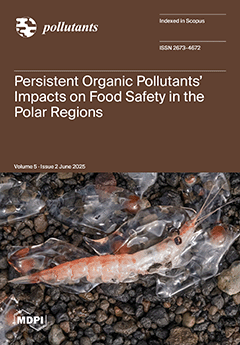The use of ultraviolet (UV) for water disinfection is known for its chemical-free process and with no harmful disinfection by-products. Yet, the disinfection process remains time-consuming, and many studies are limited to disinfection of one or two microbial species. Direct photolytic and glass-embedded
[...] Read more.
The use of ultraviolet (UV) for water disinfection is known for its chemical-free process and with no harmful disinfection by-products. Yet, the disinfection process remains time-consuming, and many studies are limited to disinfection of one or two microbial species. Direct photolytic and glass-embedded TiO
2 photocatalytic disinfection of four different bacterial species (
Staphylococcus aureus,
Salmonella senftenberg,
Bacillus subtilis, and
Escherichia coli) were assessed using UV-LED radiation with wavelengths of 365 nm. The optimization of the UV disinfection under different masses of the TiO
2 photocatalyst was evaluated. Additionally, the order of disinfection of the different bacteria species was assessed. The disinfection effects were measured based on the potential to reduce the number of bacteria species, calculated in colony-forming units/mL and log reduction units. The disinfection of
Staphylococcus aureus was enhanced from 1.46 log reduction units in the UV-alone treatment to a high of 5.65 log reduction units in the UV + 0.08 g TiO
2 treatment. Regarding
Salmonella senftenberg, disinfection was enhanced from 1.26 log reduction units to 3.85 log reduction units in UV-alone experimental treatments and UV + 0.04 g TiO
2, respectively. Similarly, an increase in
Bacillus subtilis reduction was achieved from a low of 0.69 log reduction units to a high of 2.98 log reduction units in UV-alone treatments and UV + 0.08 g TiO
2, respectively. The disinfection of
Escherichia coli was enhanced from 2.49 log reduction units (UV-alone treatment) to a high of 6.35 log reduction units (UV + 0.02 g TiO
2). The findings provide key implications and new insights into the studied bacteria species and the future application of porous glass-embedded TiO
2 photocatalysts to enhance bacteria disinfection using UV light for improved water.
Full article





